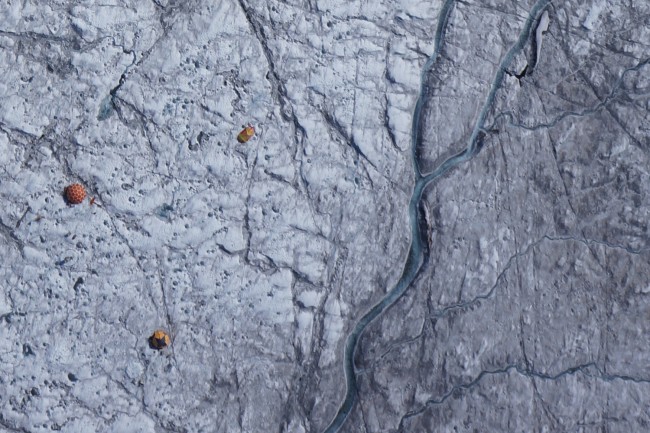Greenland’s ice sheet has a mysterious dark zone that has been getting darker in recent years. Scientists now reveal what’s behind this anomaly.
This sounds like it belongs in the realm of science fiction, but it’s a rather mellifluous name for the ice sheet’s ablation zone. Ablation is a technical term in glaciology that refers to any process that removes snow, ice, or water from a glacier, sheet, shelf, or snowfield. This involves a whole host of processes, including melting, ice calving, avalanches, surface collapse, and the wind.
In this case, the ice sheet has a continuous ablation zone that’s 400 kilometers wide (250 miles) and 100 kilometers (62 miles) up from the margin of its western flank. The dirty-looking area is bounded and perhaps pockmarked by plenty of those beautiful, ominous meltwater lakes – and, as the paper notes, it’s been getting bigger.
“From 2000 to 2012, the spatial extent of the dark zone increased by 12 percent,” as well as showing plenty of size changes within each year. This suggests that the changes aren’t occurring simply as the melting of the winter snowpack reveals the darker sediment layers beneath it. Something else is going on, but what?
The area’s not easy to access, so remote viewing has played a role. For some time, satellites, including NASA’s multispectral MODIS contraption, was used to image the Dark Zone. An international team, led by Aberystwyth University, wanted to study it in more detail – so, as is the fashion these days, they recruited the use of drones.
Thanks to a massive jump in resolution, the team found out that the Dark Zone is partly comprised of wildfire-derived black carbon and a substance known as “cryoconite,” a powder-fine material made of ice algae remnants and tiny sediments that are carried by the wind.
Much of the dark hue, however, appears to come from “biologically-active impurities”, mostly ice algae collections typified by a grey/brown coloration created by pigmentation. As it turns out, this type of algae represents a longstanding antagonist of sorts.
The authors point out that the Greenland Ice Sheet is the “largest cryospheric contributor to global sea-level rise, predominantly through increased surface melt and runoff,” something which is responsible for over half of its total mass loss since 1991. Between 1992 and 2014, it’s cumulatively lost 3.6 trillion tonnes of ice, and that loss rate is accelerating.
This Dark Zone doesn’t help things. Its colorific nature gives it what is known as a lower albedo, which allows it to absorb plenty more solar radiation than the more reflective ice around it. This exacerbates surface melting, which will in turns lower the region’s albedo further.
That’s where the algae come into play. The melting out of the trapped particles here is providing nutrients for the surface algae to proliferate, which hints at a worrying positive feedback cycle. If the algae are allowed to bloom though even marginally increased surface melt, then the Dark Zone will continue to expand.
Study co-author Prof. Alun Hubbard of Aberystwyth told IFLScience that “the scientific jury is still out on how exactly unstable the Greenland ice sheet is.” However, the Dark Zone’s algae-controlled “strong positive feedback loop… is not good news for Greenland’s contribution to global sea-level rise.”
Still, the degree to which the Dark Zone has an influence on overall stability isn’t clear. This is why the Dark Snow Project, whose members were also involved in this new study, is on a mission to find out.















